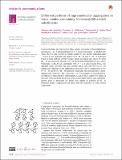Files in this item
Different patterns of supramolecular aggregation in three amides containing N-(benzo[d]thiazolyl) substituents
Item metadata
| dc.contributor.author | Mahesha, Ninganayaka | |
| dc.contributor.author | Yathirajan, Hemmige S. | |
| dc.contributor.author | Nagma Banu, Holalagudu A. | |
| dc.contributor.author | Kalluraya, Balakrishna | |
| dc.contributor.author | Foro, Sabine | |
| dc.contributor.author | Glidewell, Christopher | |
| dc.date.accessioned | 2021-05-27T08:30:09Z | |
| dc.date.available | 2021-05-27T08:30:09Z | |
| dc.date.issued | 2021-05 | |
| dc.identifier | 274370731 | |
| dc.identifier | aa37d4ca-3257-4657-a7c3-3064ae59921e | |
| dc.identifier | 85105731071 | |
| dc.identifier | 000648788100008 | |
| dc.identifier.citation | Mahesha , N , Yathirajan , H S , Nagma Banu , H A , Kalluraya , B , Foro , S & Glidewell , C 2021 , ' Different patterns of supramolecular aggregation in three amides containing N -(benzo[ d ]thiazolyl) substituents ' , Acta Crystallographica Section E Crystallographic Communications , vol. 77 , no. Part 5 , pp. 504-511 . https://doi.org/10.1107/S2056989021003637 | en |
| dc.identifier.issn | 2056-9890 | |
| dc.identifier.other | RIS: urn:6D83630D0A553911F09565248FE27162 | |
| dc.identifier.uri | https://hdl.handle.net/10023/23261 | |
| dc.description | HSY is grateful to the UGC, New Delhi, for the award of a BSR Faculty Fellowship for three years. | en |
| dc.description.abstract | Crystal structures are reported for three amides containing N-benzo[d]thiazole substituents. In N-(benzo[d]thiazol-6-yl)-3-bromobenzamide, C14H9BrN2OS, where the two ring systems are nearly parallel to one another [dihedral angle = 5.8 (2)°], the molecules are linked by N—H⋯O and C—H⋯N hydrogen bonds to form ribbons of R33(19) rings, which are linked into sheets by short Br⋯Br interactions [3.5812 (6) Å]. N-(6-Methoxybenzo[d]thiazol-2-yl)-2-nitrobenzamide, C15H11N3O4S, crystallizes with Z′ = 2 in space group Pna21: the dihedral angles between the ring systems [46.43 (15) and 66.35 (13)°] are significantly different in the independent molecules and a combination of two N—H⋯N and five C—H⋯O hydrogen bonds links the molecules into a three-dimensional network. The molecules of 5-cyclopropyl-N-(6-methoxybenzo[d]thiazol-2-yl)isoxazole-3-carboxamide, C15H13N3O3S, exhibit two forms of disorder, in the methoxy group and in the cyclopropylisoxazole unit; symmetry-related pairs of molecules are linked into dimers by pairwise N—H⋯N hydrogen bonds. Comparisons are made with the structures of some related compounds. | |
| dc.format.extent | 8 | |
| dc.format.extent | 1687709 | |
| dc.language.iso | eng | |
| dc.relation.ispartof | Acta Crystallographica Section E Crystallographic Communications | en |
| dc.subject | Benzo[d]thiazoles | en |
| dc.subject | Crystal structure | en |
| dc.subject | Disorder | en |
| dc.subject | Halogen bonding | en |
| dc.subject | Heterocyclic compounds | en |
| dc.subject | Hydrogen bonding | en |
| dc.subject | Molecular conformation | en |
| dc.subject | QD Chemistry | en |
| dc.subject | DAS | en |
| dc.subject.lcc | QD | en |
| dc.title | Different patterns of supramolecular aggregation in three amides containing N-(benzo[d]thiazolyl) substituents | en |
| dc.type | Journal article | en |
| dc.contributor.institution | University of St Andrews. School of Chemistry | en |
| dc.identifier.doi | https://doi.org/10.1107/S2056989021003637 | |
| dc.description.status | Peer reviewed | en |
This item appears in the following Collection(s)
Items in the St Andrews Research Repository are protected by copyright, with all rights reserved, unless otherwise indicated.

